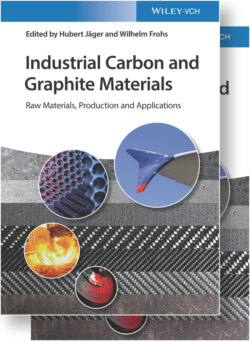Читать книгу Industrial Carbon and Graphite Materials - Группа авторов - Страница 34
3.7 Development of Synthetic Graphite
ОглавлениеAs mentioned above, synthetic graphite substituted the natural one since the beginning of the twentieth century because of the growing demand of electric engineering. In 1895, the American Edward Goodrich Acheson (1856–1931) discovered the “crosswise graphitization” process of prebaked carbon bodies, composed of pitch coke or petroleum coke with coal‐tar pitch as carbonizing binder. These molded bodies are transformed into crystalline graphite by direct electric heating crosswise to their longitudinal axis up to around 3000 °C during about 2.5 weeks [12]. A faster process, i.e. completed in just one day, as devised by the American electrochemist Hamilton Young Castner (1858–1899) already in 1893, uses a lengthwise graphitization and became today the industrially favored alternative because of energetic and economic advantages.
During the twentieth century, graphite electrodes for electric arc furnaces for the production of electrosteel from scrap and prereduced iron pellets became the dominant application of synthetic graphite with a worldwide consumption of about 1 × 106 t annually. The share of electrosteel in the overall production of crude steel (>1 × 109 t/yr) grew to about 30%. Graphitic carbon anodes (non‐graphitized) are produced and used nowadays predominantly for the electrochemical production of aluminum from clay according to the parallel inventions in 1886 of the American Charles M. Hall (1863–1914) and the Frenchman Paul Louis Toussaint Héroult (1863–1914) with a growing annual rate of about 5.8%.
A pure form of graphite can be used as moderator in nuclear reactors. Firstly in 1942, the Italian physicist Enrico Fermi (1901–1954, 1938 Nobel Prize in Physics) and his American working group used such “nuclear graphite” in their pile at the University of Chicago for the first successful nuclear fission of uranium (235U) with neutrons as controlled self‐sustaining chain reaction. In the 1960s He‐gas‐cooled high‐temperature nuclear reactors (HTRs) were developed in the United States and the United Kingdom and in Germany as pebble‐bed reactor with spherical fuel elements with graphite shell and embedded carbon‐coated particles of radioactive fuel, e.g. uranium or thorium oxide or carbide. Raw material for this pebble‐bed nuclear graphite was inter alia a special low‐anisotropic (“isotropic”) coal‐tar pitch coke tested by longtime irradiation. A commercial pebble‐bed He‐gas‐cooled HTR went on stream at Hamm‐Uentrop (Westphalia) but then was turned off because of political reasons. After that since 2007, similar inherently safe nuclear reactors (core meltdown impossible!) were planned in China, South Africa, and Japan.
